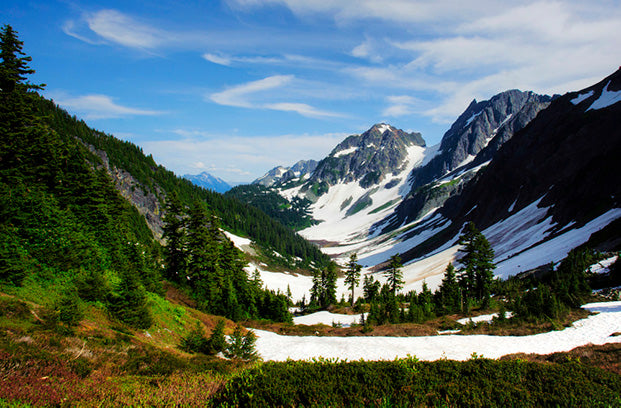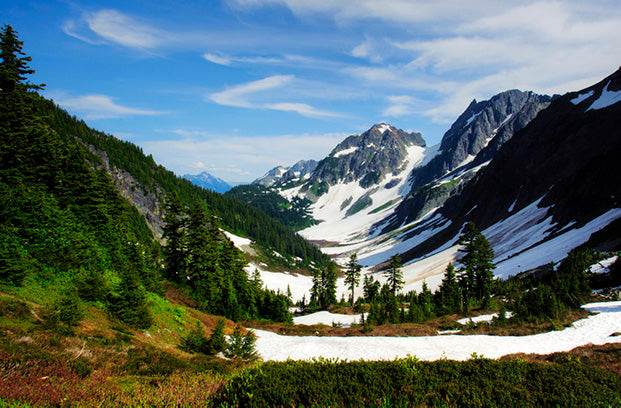Less than three hours from Seattle, an alpine landscape beckons. Discover communities of life adapted to moisture in the west and recurring fire in the east. The Cascade Range is often called the American Alps, and at North Cascades National Park you can explore its jagged peaks crowned by more than 300 glaciers. This area is a treasure trove of ecological diversity and a rugged wilderness playground for sightseers, hikers, climbers, and boaters. North Cascades National Park is located in the state of Washington.
My name is Rob Decker and I'm a photographer and graphic artist with a single great passion for America's National Parks! Cascades National Park you'll see glacier-clad peaks rising almost vertically from thickly forested valleys. Listen to cascading waterfalls. Discover communities of life adapted to moisture in the west and recurring fire in the east. And witness a landscape sensitive to the Earth's changing climate. So if this is your first time to the Cascades, or you're returning after many years, here are some things you should know about North Cascades National Park.
Hiking
Day Hiking
What sort of hike do you want to take? Perhaps a peaceful stroll down to the river, looking for birds and wildlife, or a glimpse of migrating salmon? In the mood to push your limits, climb to the heights and watch the world unfold below you? Short or long, low elevation or high, there are hundreds of miles of trails awaiting your discovery throughout the season. There are so many hikes at North Cascades National Park...and too many to list here. Follow this link to see the list of hikes and the North Cascades web site.

NPS Photo
Backpacking
Backpacking options in the park run the gamut from short, one-night trips along a river or to a lake or high point, to multi-day treks up valleys and over multiple passes. The region is also known for the multitude of mountaineering opportunities, also from short climbs to lengthy bushwhacking and climbing epics.
Camping
Wilderness Camping

NPS Photo
There are many places to camp in the Stephen Mather Wilderness and the backcountry of the park. Within the trail corridors, there are almost 140 designated sites. Camping in the trail corridors is allowed only at these camps, which are designed to provide a safe and low-impact camping experience. Most camps are located off the main trail, to provide privacy and a sense of solitude for passing hikers. Each camp has a flat tent pad area, pit or composting toilet, and access to water. Designated camps at lower elevations also have an established fire ring.
Boat-in Camping
Seclusion, scenery, and still water. Twenty-five boat-in camps dot the backcountry shorelines of North Cascades National Park Complex. On Lake Chelan, explore the shoreline of a water pathway used by human travelers for thousands of years. In the Skagit Valley along State Route 20, visit the hidden coves, islands, and bays of Diablo and and Ross Lakes, both reservoirs created by the dams on the Skagit Hydroelectric Project. Whether you spend a night or a week, boat-in camping within the park complex is a unique experience.
Climbing
North Cascades National Park is renowned for its varied and rugged climbing terrain. Here you will find climbing routes of high quality and aesthetic appeal, guarded by remote, rugged access and weather volatility, resulting in mountaineering experiences of mental and physical challenge, solitude, and fulfillment. The numerous peaks and over 300 glaciers present a variety of challenges and rewards: classic mixed mountaineering routes, intricate glacier travel, technical rock climbing and scrambling, all within a premier wilderness setting.

NPS Photo
Approach routes are often arduous, requiring strenuous cross country travel, sometimes for days or through thick slide alder, rocky avalanche shoots and scree slopes, icy creeks or rivers, steep snow, or traversing slopes in steep, slippery terrain. The physical and mental challenge can push climbers to their limits, and changes in the weather can foil a summit bid. But when you finally stand on the top of a summit in the North Cascades, looking out over a jagged, glaciated mountain range that finds its finest and highest expression here in the park, as you tower over the alpine meadows and deep valleys, you will understand why these peaks draw climbers and wilderness travelers again and again, and you will begin to plot your next climb in these mountains.
Bird and Wildlife Viewing
Birds are significant components of biological diversity within the North Cascades ecosystem. More than 200 species in 38 families can be found in park habitats that range from alpine meadows to low elevation forests and wetlands. Two species (marbled murrelet and spotted owl) are listed as "threatened" under the federal Endangered Species Act.

NPS Photo
The North Cascades is one of the most diverse ecosystems on the planet. Animals with fins, fur, feathers and scales are all at home in this dramatic and beautiful environment. Elusive mammals like the gray wolf, fisher and wolverine wander the wilderness in small numbers, while more adaptable Columbia black-tailed deer, Douglas squirrels and pikas delight park visitors in abundance. Fish and amphibians lurk in the clear mountain lakes and streams. The rich forests, rocky slopes and clean waters teem with invertebrate life, such as butterflies, dragonflies, stoneflies and mayflies. North Cascades is home to approximately 75 mammal species in 20 families; 21 species of reptiles and amphibians representing at least four orders; 28 species of fish; and recent surveys have documented more than 500 types of land insects and approximately 250 aquatic invertebrate species.
Bicycling
Bicycling in North Cascades is exciting and challenging. Riding conditions vary from leisurely and quiet in the lower Stehekin Valley to the steep and sometimes heavily trafficked climbs out of the Skagit River gorge on Highway 20. Bicycles are permitted on all roads open to public automobiles. They are not permitted on trails. Cyclists should be prepared to experience variable weather and carry the tools necessary to make roadside repairs.
Cycling on the North Cascades Highway
Opened to the public in 1972, this was the last major road to be constructed across the Cascade Range in Washington. This scenic and adventurous trip offers a chance for cyclists to traverse one of the most remote and diverse mountain ranges remaining in the lower 48 states, and with total elevation gains exceeding 7,000 feet it can challenge even the fittest cyclists.
Stehekin Valley
Bicycling the Stehekin Valley Road is popular and well suited for families. You can transport bicycles on the Lady of the Lake ferries or rent them from Discovery Bikes, .25 miles from the ferry landing in Stehekin. Cyclists can also utilize the shuttle service to transport bikes up valley to High Bridge and ride the mostly downhill road back to the lower valley. Private property is scattered throughout this area, so please respect the rights of landowners.
Stehekin
The name "Stehekin" is based on a Salishan word meaning "the way through." The Stehekin valley has long served as a passageway for travelers, linking Washington's interior wilderness to the rugged Cascade Mountains. Today Stehekin offers vistors an escape from the hustle of the modern day world. Nestled at the headwaters of Lake Chelan, the third deepest lake in America, the Stehekin community lives life a little slower. There are no roads into Stehekin.

Connected to the outside world only by foot, boat or plane, the voyage to Stehekin is part of the experience and once you've arrived, a variety of historical, cultural, and outdoor activities will connect you with the majestic surroundings. Stehekin serves as a hub to explore the 61,949-acre Lake Chelan National Recreation Area and a gateway to the rest of the North Cascades National Park Service Complex, Stephen Mather Wilderness, and adjacent National Forest Wilderness Areas.
Source: https://national-park-posters.com/blogs/national-park-posters/best-things-to-do-at-north-cascades-national-park
